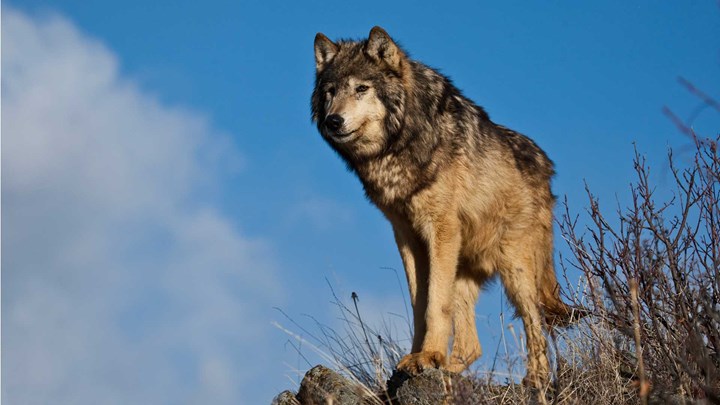
by Mark Chesnut - Friday, September 5, 2025

We’ve chronicled here many times the problems released gray wolf populations can cause for livestock owners and big game species. For just one example, look at Montana where wolf numbers have burgeoned over the past 45 years to the point Montana Fish, Wildlife and Parks biologists recently recommended a greatly increased wolf harvest. The proposal was approved by the Montana Fish and Wildlife Commission (MFWC) on Aug. 31, and the increases are notable.
According to Newstalk KGVO Radio in Missoula, the MFWC raised the overall harvest quota from 334 to 458 wolves, which marks a 37% increase, while getting rid of the previously established region-by-region caps. The only exceptions are a 60-wolf quota in Region 3 (southwest Montana) and limits of three each in the units bordering Yellowstone National Park—units 313 and 316. Last season, hunters and trappers harvested 297 wolves, but state wildlife agency officials say they hope the new regulations will lead to a larger assist with population decline.
In addition, the MFWC raised personal tag limits from 10 to 15 each, meaning one person could legally take up to 30 wolves in a year. However, five hunted and five trapped wolves would need to come from the wolf-heavy northwest.
For some background on this issue, though extirpated from Montana in the early 1900s, wolf recovery efforts began in the early 1980s. By 2002, the northern Rockies wolf population met the biological recovery criteria of 30 breeding pairs for three consecutive years in the Northern Rocky Mountains (NRM) of Montana, Idaho and Wyoming. In preparation for delisting, Montana developed its initial Wolf Conservation and Management Plan based on the work of a citizen’s advisory council, which was approved by the U.S. Fish and Wildlife Service (USFWS) in 2004. Delisting was not immediate, however, and the wolf population in the NRM tripled between the time recovery goals were met and when wolves were ultimately delisted by Congress in 2011.
Continued growth of the populations, and wolves’ increased interaction with livestock and ranchers, prompted state wildlife managers to initially propose a harvest of 500 wolves for the 2025-2026 season, up from the 300-wolf quota last year when 289 wolves were killed by hunters and trappers. Along with the increased overall harvest by hunters and trappers, the recently approved regulations allow hunters and trappers to take as many as 15 wolves each, up from the previous harvest limit of 10.
The increased harvest is necessary to curb livestock depredation by wolves. In 2024, wolves killed 35 cattle, 16 sheep, three foals and eight livestock guard dogs statewide, according to wildlife officials. An additional 17 cattle and one livestock guard dog were probable wolf kills. Total confirmed cattle losses for 2024 were increased from 2023.
Reimbursement totals for calendar year 2024 wolf depredations were $86,974 paid to 28 livestock owners on 60 head of livestock and four dogs. These numbers differ slightly from the confirmed losses due to wolves because reimbursements are also made for probable wolf depredations and totaled by calendar year rather than federal fiscal year.
As with most proposals dealing with wolves, this one had its advocates and its detractors. One group that liked the idea was the Rocky Mountain Elk Foundation (RMEF), which believes that expanding wolf populations has led to diminished elk and deer numbers.
“Northwest Montana is densely populated with wolves and is also in a part of the state where people are clearly frustrated by (lower) deer and elk populations,” Ryan Bronson, RMEF director of government affairs, told the Cowboy State Daily.
Anti-hunting advocates, of course, decried the plan, pointing out that 500 wolves is nearly half of the state’s population, estimated at about 1,050 animals.
Lizzy Pennock, so-called “carnivore coexistence attorney” for the anti-hunting organization WildEarth Guardians, told the Cowboy State Daily that Montana’s wolf policy has been too heavy-handed for years. She questions why any wolf hunting and trapping is necessary. Obviously, she doesn’t raise cattle or sheep in areas where wolves have chosen the easy route of preying on livestock instead of elk and deer.
Even if 500 wolves were killed in the upcoming hunting season, which is unlikely given last year’s total, the remaining 550 wolves still would be well above the threshold level for possible re-listing under the Endangered Species Act. Yet Pennock’s group has joined with others to file a lawsuit calling for wolves to be re-listed.
One thing no pro-wolf or anti-hunting organizations are likely to mention is the amount of money wolf hunting produces for conservation of the species. Wolf license sales have generated nearly $5.7 million for wolf management and monitoring since 2009.
About the Author
Freelance writer and editor Mark Chesnut is the owner/editorial director at Red Setter Communications LLC in Jenks, Okla. An avid hunter, shooter and field-trialer, he has been covering Second Amendment issues and politics on a near-daily basis for over 25 years.
Photo by Tim Christie; timchristiephoto.com
E-mail your comments/questions about this site to:
[email protected]
Proudly supported by The NRA Foundation and Friends of NRA fundraising.
